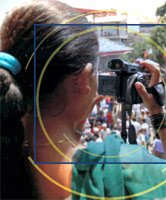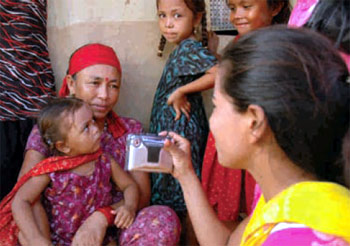UNESCO releases “Forging Innovations: Community Multimedia Centres in Nepal”
20-12-2007 (New Delhi)

Photo from the publication cover
© UNESCO
This collection of case studies on the Community Multimedia Centres (CMCs) in Nepal is intended to showcase the interesting and diverse growth of this initiative in spite of conflict and the lack of community radio regulation in the country.
The publication introduces the CMCs and outlines the benefits and challenges that the centres have faced since they were established. Each CMC is discussed in four parts: location and context, organisational structure, programmes and sustainability. The case studies show how local communities access and utilise newly available ICT tools in different ways.
In 2003 UNESCO supported the creation of Nepal's first pilot CMC in Tansen, Palpa. Since then, the Organisation has assisted in the creation of two additional CMCs in Nepal, one in Madanphokhara (Palpa District) and another in Lumbini (Rupandehi District). The three CMCs are now networked to five telecentres throughout Rupandehi and Palpa Districts.
The CMC media mix in Nepal consists of FM broadcasting services, cable TV network, design and desktop publishing software applications, audio and video editing, and public access points for Internet, telephone, fax, photocopiers and scanners.
In an effort to understand the social impact of CMCs the authors, Karma Tshering and Kirsty Martin, carried out field visits to the centres. They interviewed managers, staff, local researchers, community reporters, volunteers and community people. Unobtrusive observations of the centres were conducted to gain a sense of the normal daily activities.
By examining three centres concurrently, common themes emerged in the overall functionality of CMCs in Nepal. This study identifies some key issues which can assist CMCs towards their goal of providing ICT access to poor and marginalised communities in regional Nepal.
The publication is available here in PDF format.
In 2003 UNESCO supported the creation of Nepal's first pilot CMC in Tansen, Palpa. Since then, the Organisation has assisted in the creation of two additional CMCs in Nepal, one in Madanphokhara (Palpa District) and another in Lumbini (Rupandehi District). The three CMCs are now networked to five telecentres throughout Rupandehi and Palpa Districts.
The CMC media mix in Nepal consists of FM broadcasting services, cable TV network, design and desktop publishing software applications, audio and video editing, and public access points for Internet, telephone, fax, photocopiers and scanners.
In an effort to understand the social impact of CMCs the authors, Karma Tshering and Kirsty Martin, carried out field visits to the centres. They interviewed managers, staff, local researchers, community reporters, volunteers and community people. Unobtrusive observations of the centres were conducted to gain a sense of the normal daily activities.
By examining three centres concurrently, common themes emerged in the overall functionality of CMCs in Nepal. This study identifies some key issues which can assist CMCs towards their goal of providing ICT access to poor and marginalised communities in regional Nepal.
The publication is available here in PDF format.
 Student completes his classwork listening to a CMC programme (photo from the publication).
Student completes his classwork listening to a CMC programme (photo from the publication).© UNESCO
 Community reporter covers the citizenship issue for the Lumbini CMC programme (photo from the publication).
Community reporter covers the citizenship issue for the Lumbini CMC programme (photo from the publication).© UNESCO
Related themes/countries
· Nepal
· CMC: News Archives 2007
Share this story:














